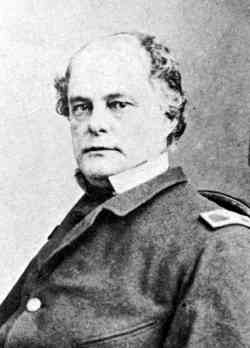John Rodgers |
|
|---|---|
| Born | 7/11/1772 in Havre de Grace, Maryland |
| Died | 8/1/1838 in Philadelphia, Pennsylvania |
Biography |
|
BiographyRodgers was born near present-day Havre de Grace, Maryland. He entered the Navy as Second Lieutenant when it was organized on March 8, 1798, and was assigned to the Constellation. He helped capture French frigate L'Insurgente on February 9, 1799, and took command of her as prize master. He was promoted to Captain on March 5, 1799 and three months later took command of the Maryland. In March 1801, he transported the ratified Convention of 1800 (Treaty of Mortefontaine), which ended the Quasi-War, to France. Placed in command of the John Adams the following year, he sailed for the Mediterranean to attack Barbary forts and gunboats at Tripoli, as part of the First Barbary War. His brilliant record fighting the corsairs won him appointment as Commodore of the Mediterranean Squadron in May 1805. A year later, he returned to the United States to take command of the New York Flotilla. After the Embargo Act was passed at the close of 1807, Rodgers commanded operations along the Atlantic coast enforcing its provisions. In 1811, he was in command as Commodore of the President off Annapolis when he heard that an American seaman had been "impressed" by a British frigate off Sandy Hook, New Jersey. Commodore Rodgers was ordered to sea to "protect American commerce", but he may have had verbal instructions to retaliate for the impressment of British subjects out of American vessels, which was causing much ill-feeling and was a main cause of the War of 1812. On the 16 May 1811, he sighted and followed the British sloop Little Belt, and after some hailing and counterhailing, of which very different versions are given on either side, a gun was fired, each side accusing the other of the first shot, and an action ensued in which Little Belt was cut to pieces. On the sixth day of the War of 1812, still in President, Rodgers drove off British frigate Belvidera and chased her for eight hours before she escaped. He was wounded during this engagement when a gun burst near him. Rodgers commanded the President for most of the war, capturing 23 prizes. On land, Rodgers rendered valuable service defending Baltimore during the British attack on Fort McHenry. Following the war, Rodgers headed the Board of Navy Commissioners until retiring in May 1837. Commodore Rodgers died in Philadelphia, Pennsylvania on August 1, 1838. Influence and legacyCommodore Rodgers established a naval "dynasty" that produced several other notable officers. His son John Rodgers (1812–1882) served in the American Civil War, and his great-grandson John Rodgers (1881–1926) served in World War I. Six ships have been named in their honor, three as USS John Rodgers and three as USS Rodgers. Louisa, daughter of Commodore Rodgers, was married to Union General Montgomery C. Meigs; their son John Rodgers Meigs was killed in the Civil War in 1864. (General Meigs was a great grandson of Continental Army Colonel Return J. Meigs, Sr.). His home, Sion Hill, was added to the National Register of Historic Places in 1990, and designated a National Historic Landmark in 1992. |
|
 John Rodgers (July 11, 1772 - August 1, 1838) was an American naval officer who served in the United States Navy from its organization in the 1790s through the late 1830s. His service included the Quasi-War with France and the War of 1812.
John Rodgers (July 11, 1772 - August 1, 1838) was an American naval officer who served in the United States Navy from its organization in the 1790s through the late 1830s. His service included the Quasi-War with France and the War of 1812.